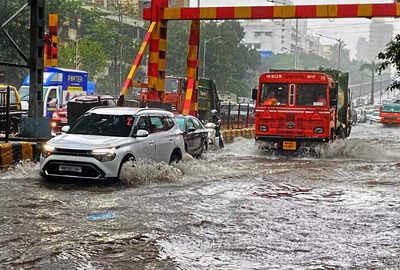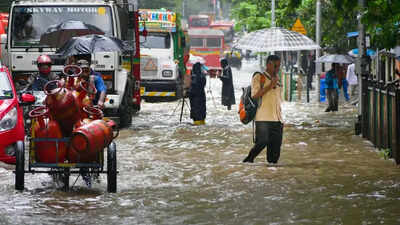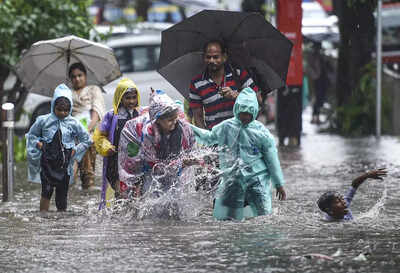Top Searches
- News
- India News
- Why monsoon chokes Mumbai year after year
Why monsoon chokes Mumbai year after year
MUMBAI: The Maximum City and its suburbs received over 200mm rainfall in 36 hours ending Tuesday afternoon as the very wet spell that started almost a week ago continued.
The IMD has issued an orange alert (extremely heavy rain) for Mumbai and Thane for Thursday and Friday.
While the heavy rainfall brought relief to Mumbaikars and replenished lakes, it also triggered traffic woes, waterlogging and once again led to pothole problem and flooding in the city.
Traffic had to be stopped at places like the Andheri and Khar subways and Sion road.

So, why does Mumbai choke year after year?
* Firstly, more rains in shorter period of time means greater strain on Mumbai’s drains. Excess water gets logged in all available low lying areas.
* Secondly, besides rains, Mumbai gets its water from a web of rivers — Mithi (18 km), Dahisar (12 km), Poisar (7 km) and Oshiwara (7 km). Rising population, expanding settlements, garbage dumping, industrial effluents, sewage and wastewater have also reduced their water discharge capacity into the Arabian Sea.
* Thirdly, Mumbai drains its waste and excess water through its storm water drainage system (SWDS), originally designed during the 1860s by the British. After the 2005 deluge, the Maharashtra government and Mumbai's civic agencies decided to revive SWDS projects. However, the monsoon exposes its inefficiency every year.
Mumbai rains live updates
How recent rains impacted Mumbai?
Waterlogging and heavy traffic were seen particularly in Andheri, Ghatkopar, Chembur, Dharavi, Dadar, Wadala and Panvel. People were seen wading through water, and roads in Sion area were also flooded.
NDRF teams have been deployed in Mumbai and other parts of Maharashtra due to heavy rainfall. Chief minister Eknath Shinde, who reviewed the rain situation, said over 3,500 people were shifted to safer places across the state.
The city's four key arterial subways — the Golibar, Milan, Andheri and Malad — that connect the east and west stretches of the north-western suburbs had to be closed.
Mumbai received an average 95.81 mm rainfall in the 24 hour period ending at 8 am on Tuesday. Its eastern and western suburbs recorded 115.09 mm and 116.73 mm rainfall.
On Tuesday morning, Mumbai had received an average 41 mm rainfall. The eastern and western suburbs got 85 mm and 55 mm showers.
69% of July average received in 5 days
According to IMD, the city’s average rainfall for July stands at 855. 7mm, of which almost 596mm has been received till Tuesday.
The intensity of Tuesday’s downpour was clearly evident in the rainfall recordings — in just six hours from 8. 30am to 2. 30pm, IMD’s Santacruz observatory recorded 115. 3mm rain. And the Met department indicated the downpour was expected to continue. By 5. 30pm, the rain gauge levels at Santacruz had touched 153. 3mm; at IMD Colaba it was 48. 6mm.

The intense rainfall over the past few days has wiped out the shortfall in June rain. IMD Santacruz’s total rainfall for the season now stands at 733mm, which is 13mm higher than the season’s average.
IMD had declared the onset of monsoon on time on June 11 this year and pre-monsoon showers began encouragingly around June 9.
However, rain played largely truant for the rest of the month, and June eventually ended without meeting its rain target.
Lake levels up 6% in a week
Bringing some cheer, stocks in the seven lakes that supply water to Mumbai rose by around 6% in the last one week thanks to the wet spell the Konkan coast is witnessing. The two lakes that received the maximum rain in the 24 hours ending 6am on Tuesday were Vihar and Tulsi — 119mm and 227mm, respectively.
On Tuesday, water levels in the lakes stood at 15% of the city’s required annual quantum. Just a week ago on June 27, the stocks had dipped to 9%, prompting the civic body to bring into effect a 10% cut in water supply to the city.
As of Tuesday, the total water stocks in the lakes crossed 2 lakh million litres and civic officials said they are hoping it will increase in the coming days with the forecast indicating heavy rains.
Powai lake starts overflowing
Amid incessant rain over the past few days, Powai lake in Mumbai’s eastern suburbs began overflowing at 6.15 pm on Tuesday.
In 2020, it started overflowing on the exact same day -July 5 -but last year it was full by June 12.
The water is unfit for human consumption and is used for industrial purposes only. The lake was constructed in 1890 at a cost of Rs 12.6 lakh and is too shallow to be used for domestic water supply.
Tree falls near chief minister's home
Besides waterlogging, Thane city, which received 60mm heavy rainfall since Tuesday morning, saw several mishaps, including tree fall and mudslides. As many as nine trees, including a huge one near the residence of new chief minister Eknath Shinde along the Eastern Express Highway, fell.
The torrential Tuesday rain saw many areas in the city’s suburbs receive over 100mm rainfall in less than 10 hours. Bandra recorded 139mm, Marol 136mm, Chembur 145mm, Vikrohli 164mm and Ghatkopar 138mm between 8am-5pm on Tuesday.
It led to severe waterlogging in low-lying areas, disrupting traffic and normal life. Matunga, Hindmata, King’s Circle and Gandhi Market got flooded, but traffic at Gandhi Market did not stop, unlike earlier, after the BMC constructed underground water tanks in the area.
Sion resident R Sridhar said Gandhi Market roads did get waterlogged, but “the water drained off very quickly and traffic along the road, although restricted to a few lanes, kept moving throughout”.
Vehicular traffic was briefly affected on the Mumbra bypass highway on Tuesday morning after a small stretch witnessed mudslide from the adjoining hillocks on the Panvel-to-Thane lane. A team of earthmovers was deployed that cleared the slush accumulated on the driveway, said officials.
The IMD has issued an orange alert (extremely heavy rain) for Mumbai and Thane for Thursday and Friday.
While the heavy rainfall brought relief to Mumbaikars and replenished lakes, it also triggered traffic woes, waterlogging and once again led to pothole problem and flooding in the city.
Traffic had to be stopped at places like the Andheri and Khar subways and Sion road.
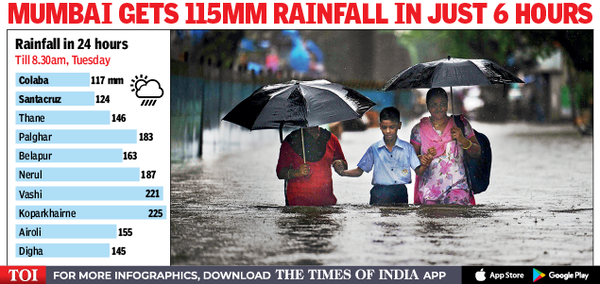
So, why does Mumbai choke year after year?
* Firstly, more rains in shorter period of time means greater strain on Mumbai’s drains. Excess water gets logged in all available low lying areas.
* Secondly, besides rains, Mumbai gets its water from a web of rivers — Mithi (18 km), Dahisar (12 km), Poisar (7 km) and Oshiwara (7 km). Rising population, expanding settlements, garbage dumping, industrial effluents, sewage and wastewater have also reduced their water discharge capacity into the Arabian Sea.
* Thirdly, Mumbai drains its waste and excess water through its storm water drainage system (SWDS), originally designed during the 1860s by the British. After the 2005 deluge, the Maharashtra government and Mumbai's civic agencies decided to revive SWDS projects. However, the monsoon exposes its inefficiency every year.
Mumbai rains live updates
How recent rains impacted Mumbai?
Waterlogging and heavy traffic were seen particularly in Andheri, Ghatkopar, Chembur, Dharavi, Dadar, Wadala and Panvel. People were seen wading through water, and roads in Sion area were also flooded.
NDRF teams have been deployed in Mumbai and other parts of Maharashtra due to heavy rainfall. Chief minister Eknath Shinde, who reviewed the rain situation, said over 3,500 people were shifted to safer places across the state.
The city's four key arterial subways — the Golibar, Milan, Andheri and Malad — that connect the east and west stretches of the north-western suburbs had to be closed.
Mumbai received an average 95.81 mm rainfall in the 24 hour period ending at 8 am on Tuesday. Its eastern and western suburbs recorded 115.09 mm and 116.73 mm rainfall.
On Tuesday morning, Mumbai had received an average 41 mm rainfall. The eastern and western suburbs got 85 mm and 55 mm showers.
69% of July average received in 5 days
According to IMD, the city’s average rainfall for July stands at 855. 7mm, of which almost 596mm has been received till Tuesday.
The intensity of Tuesday’s downpour was clearly evident in the rainfall recordings — in just six hours from 8. 30am to 2. 30pm, IMD’s Santacruz observatory recorded 115. 3mm rain. And the Met department indicated the downpour was expected to continue. By 5. 30pm, the rain gauge levels at Santacruz had touched 153. 3mm; at IMD Colaba it was 48. 6mm.
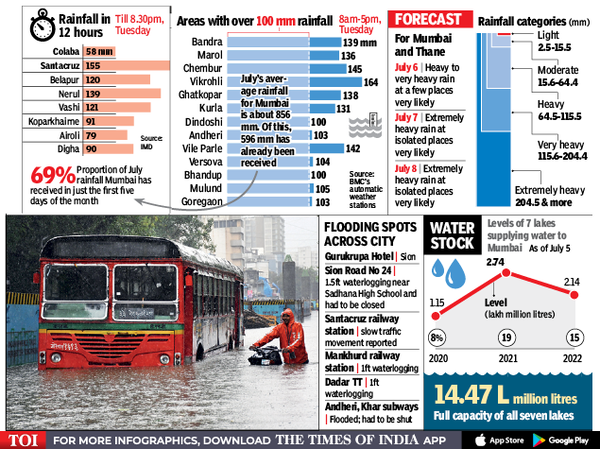
The intense rainfall over the past few days has wiped out the shortfall in June rain. IMD Santacruz’s total rainfall for the season now stands at 733mm, which is 13mm higher than the season’s average.
IMD had declared the onset of monsoon on time on June 11 this year and pre-monsoon showers began encouragingly around June 9.
However, rain played largely truant for the rest of the month, and June eventually ended without meeting its rain target.
Lake levels up 6% in a week
Bringing some cheer, stocks in the seven lakes that supply water to Mumbai rose by around 6% in the last one week thanks to the wet spell the Konkan coast is witnessing. The two lakes that received the maximum rain in the 24 hours ending 6am on Tuesday were Vihar and Tulsi — 119mm and 227mm, respectively.
On Tuesday, water levels in the lakes stood at 15% of the city’s required annual quantum. Just a week ago on June 27, the stocks had dipped to 9%, prompting the civic body to bring into effect a 10% cut in water supply to the city.
As of Tuesday, the total water stocks in the lakes crossed 2 lakh million litres and civic officials said they are hoping it will increase in the coming days with the forecast indicating heavy rains.
Powai lake starts overflowing
Amid incessant rain over the past few days, Powai lake in Mumbai’s eastern suburbs began overflowing at 6.15 pm on Tuesday.
In 2020, it started overflowing on the exact same day -July 5 -but last year it was full by June 12.
The water is unfit for human consumption and is used for industrial purposes only. The lake was constructed in 1890 at a cost of Rs 12.6 lakh and is too shallow to be used for domestic water supply.
Tree falls near chief minister's home
Besides waterlogging, Thane city, which received 60mm heavy rainfall since Tuesday morning, saw several mishaps, including tree fall and mudslides. As many as nine trees, including a huge one near the residence of new chief minister Eknath Shinde along the Eastern Express Highway, fell.
The torrential Tuesday rain saw many areas in the city’s suburbs receive over 100mm rainfall in less than 10 hours. Bandra recorded 139mm, Marol 136mm, Chembur 145mm, Vikrohli 164mm and Ghatkopar 138mm between 8am-5pm on Tuesday.
It led to severe waterlogging in low-lying areas, disrupting traffic and normal life. Matunga, Hindmata, King’s Circle and Gandhi Market got flooded, but traffic at Gandhi Market did not stop, unlike earlier, after the BMC constructed underground water tanks in the area.
Sion resident R Sridhar said Gandhi Market roads did get waterlogged, but “the water drained off very quickly and traffic along the road, although restricted to a few lanes, kept moving throughout”.
Vehicular traffic was briefly affected on the Mumbra bypass highway on Tuesday morning after a small stretch witnessed mudslide from the adjoining hillocks on the Panvel-to-Thane lane. A team of earthmovers was deployed that cleared the slush accumulated on the driveway, said officials.
FOLLOW US ON SOCIAL MEDIA
FacebookTwitterInstagramKOO APPYOUTUBE

Start a Conversation
end of article

